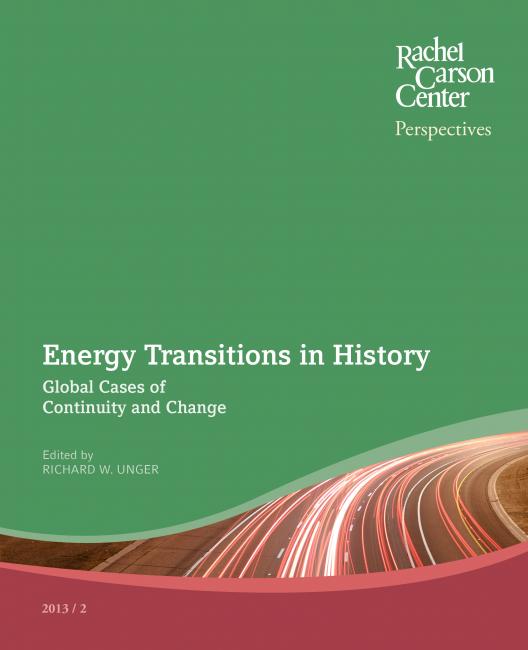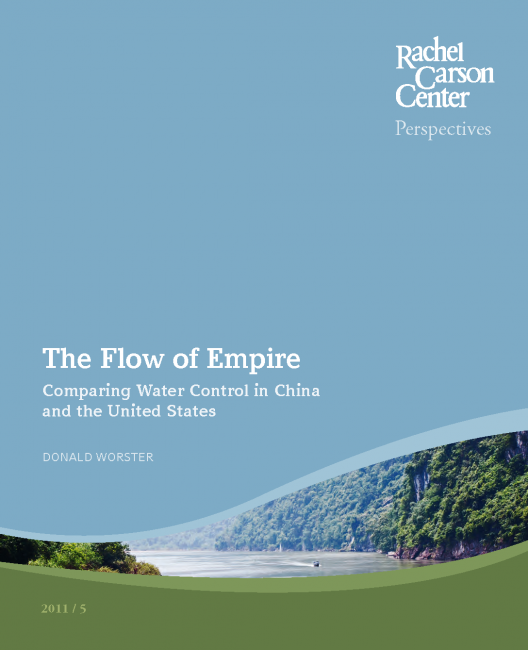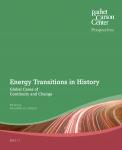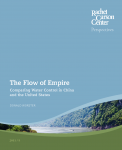Contrasting Transitions
As markets for coal spread and matured, mutually reinforcing mechanisms boosted the various energy services deployed around a common infrastructure. Coal’s long-term costs began to decline steeply due to technical improvements in mining and transportation. Commercial distribution networks expanded throughout the globe, creating a web of retail outlets around grocery stores, warehouses, and bunker stations for fuelling ships. It replaced wood for heating, and muscular force and water engines for power. Distilled coal, in turn, substituted whale and colza (rapeseed) oils for lighting. In the final decades of the nineteenth century, fossil fuels began to transform the electricity generation market: coal-fired power stations became platforms for the provision of a remarkable range of services such as outdoor lighting, indoor lighting with incandescent bulbs, industrial power, and urban transportation such as trams. In the years ahead, electricity generation would become the main driver of coal consumption worldwide. Depicted as a single course of action from the primary energy sources point of view, the classical energy transition encapsulates several differentiated processes in terms of end-user energy technologies. Compared to this pattern of classical energy transition, future changes will likely occur within shorter time spans and entail decentralized productive structures and intelligent devices, eventually blurring the distinction between energy producers and consumers. They will most certainly be driven by changes in transportation services, in building infrastructures and optimal/smart control. The share of electricity in the overall energy balance is furthermore likely to increase. Much harder to ascertain are the unexpected spillover effects along with the social, economic, and environmental impacts of structural shifts in energy production and consumption. “Low carbon economies” are unimaginable without significant changes in geographical mobility, employment, trade, agriculture and globalization. They also imply major shifts in the equilibrium between winners and losers with the resulting overhaul of policy arenas and social movements. Ultimately, energy transitions will continue to lead to the transformation of habits, individual preferences, societal values, time schedules, and leisure.
Different types of energy transitions occur at the same time. Whilst some countries embark down the path of offering incentives for the installation of efficient and competitive renewable energy system others are still circumventing the constraints of the solar agrarian energy system and its associated energy poverty.
The original exhibition features an interactive gallery of items from the Environment & Society Portal’s multimedia library with a focus on contrasting transitions. View the items on the following pages.
Gallery 2: Contrasting transitions

Cover, RCC Perspectives 2014, no. 5.
Different types of energy transitions occur at the same time. Whilst some countries embark down the path of offering incentives for the installation of efficient and competitive renewable energy system others are still circumventing the constraints of the solar agrarian energy system and its associated energy poverty. A clear picture of the inherent global diversity emerges clearly from the five histories of colonial energy projects presented by Clapperton Chakanetsa Mavhunga and Helmuth Trischler in their edited special issue of RCC Perspectives on Energy (and) Colonialism.
Mavhunga, Clapperton Chakanetsa, and Helmuth Trischler, eds. “Energy (and) Colonialism, Energy (In)Dependence: Africa, Europe, Greenland, North America.” RCC Perspectives 2014, no. 5. http://www.environmentandsociety.org/node/6554

Arcadia 2015, no. 8.
In “Corridors, Concessions, and the Extraction of Natural Resources in Liberia” Emmanuel Urey critiques the “open door” development policy promoted by the Liberian government after World War II.
Urey, Emmanuel K. “Corridors, Concessions, and the Extraction of Natural Resources in Liberia.” Environment & Society Portal, Arcadia 2015, no. 8. Rachel Carson Center for Environment and Society.
http://www.environmentandsociety.org/node/6945.

Cover, Environment and History 11, no. 4 (Nov. 2005).
In “Was Brazilian Industrialization Fuelled by Wood?” Christian Brannstrom offers a revised “wood hypothesis”: That Sao Paulo’s industrialisation depended on the interplay of three energy sources, led by biomass fuels, then fossil fuels and hydroelectricity, each of which was supplied by a distinct energy hinterland.
Brannstrom, Christian. “Was Brazilian Industrialisation Fuelled by Wood? Evaluating the Wood Hypothesis, 1900–1960.” Environment and History 11, no. 4 (Nov. 2005): 395–430. http://www.environmentandsociety.org/node/3247.

Cover, RCC Perspectives 2013, no 2.
Massive modernization projects aside, swift changes in environmental landscape are also likely to occur whenever a nation with plentiful natural resource endowments decides to ground its development strategy upon a singular resource. Such proves the case of both the natural gas revolution that swamped the Netherlands from 1959 onwards, a story spotlighted by Ben Gales.
Gales, Ben, “A Dutch revolution: Natural Gas in the Netherlands,” in “Energy Transitions in History: Global Cases of Continuity and Change,” ed. Richard W. Unger, RCC Perspectives 2013, no 2: 83-90. http://www.environmentandsociety.org/node/6226

Film Profile of The Power of Community: How Cuba Survived Peak Oil.
Another source of contrasting changes stem from sudden geo-political events whose impact shatters the established ways of life of long standing communities. In this respect, the film The Power of Community: How Cuba Survived Peak Oil conveys what happened when Cuba was forced to cut back on its oil imports in the wake of the collapse of the Soviet Union in 1991. One gains a glimpse into the intensity of a scarcity shock, even though the specifics of the Cuban economy made the transition relatively manageable. After the collapse of the Soviet Union in 1991, oil imports in Cuba were halved and food imports reduced by up to 80 percent. This film suggests that, given the perceived immanence of peak oil, there is much to be learned from the Cuban experience.
Film profile of The Power of Community: How Cuba Survived Peak Oil. Directed by Faith Morgan. Yellow Springs, OH: Arthur Morgan Institute for Community Solutions, 2006. 53 min. http://www.environmentandsociety.org/node/3799

Cover, RCC Perspectives 2011, no 5.
A good read to close this gallery is Donald Worster’s “The Flow of Empire: Comparing Water Control in the United States and China.” Worster reveals sharp contrasts in resource usage intermingled with amazing similarities. He argues that the environmental foundation of China’s empire was water control, and that the water policies of the United States can be understood in a similar way.
Worster, Donald. “The Flow of Empire: Comparing Water Control in the United States and China.” RCC Perspectives 2011, no 5. http://www.environmentandsociety.org/node/5586






Certain factors can accelerate transitions. Technological niches offer “protected spaces” for the early experimentation of radical innovations that may sow the seeds for systemic change. Such niches may be research and development laboratories, subsidized demonstration projects, or small markets where users are willing to back emerging innovations and provide feedback. As long as these spaces and facilities continue to support technologies at the prototype or small-unit-scale stages and allow for design diversity for replication and learning, they enhance the innovations’ chances of survival. Particularly in periods of destabilization in the existing techno-economic regime, niche innovations may overcome competitive barriers and move into the competitive fringes of markets. Hence, niches buy time for novel technologies. Time allows for the acquisition of experience through learning-by-doing, learning-by-using, and learning-by-interacting. Drawing on the idea that costs decrease following a learning curve, these niches enable the pursuit of cost reductions so that when circumstances allow, the competitive gap is shortened and the diffusion process accelerated.
Accordingly, energy transitions tend to be faster for latecomers and slower for pioneers. Adapting to new energy systems proves much easier when there are none of the sunk costs in capital intensive equipment, network economies of interconnected infrastructures and the human resources and institutions devoted to the old system. In this respect, analysis of less-developed countries demonstrates how some regions have leapfrogged entire stages in the Western historical energy transition path as happened with the abrupt changeover from coal to oil by Costa Rica, Cuba, Mexico, and Peru in the early twentieth century, or in the swift domestic substitution of charcoal and firewood by butane gas in Senegal and Botswana at the close of the twentieth century. Overall, the more the transition focuses on the substitution of end-user technologies rather than the displacement of large and complex energy systems, the easier and the faster the process of change. This point tips the balance towards the design of flexible, semi-autonomous, and decentralized energy usage systems.








